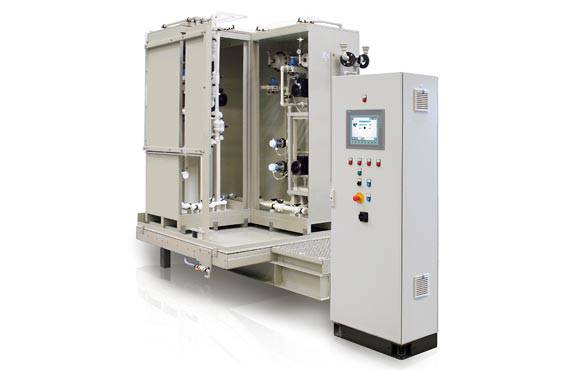Technical Publication: Sulphuric acid - benchmark for the industry
Sulphuric acid is one of the technically most important chemicals of all and ranks among the most-produced raw materials.
The chemical is used in various concentrations in many industrial areas. Its production quantity is considered – in addition to chlorine – as a benchmark for the industrial development and performance level of a country. The annual production volume globally is around 200 million tons, five million in Germany alone. The largest part of the production goes into the production of fertilisers.
As battery acid, 37% sulphuric acid is a key component of lead batteries, as used in the automotive industry, for example, in starter batteries.
Furthermore, the chemical is one of the most common raw materials in chemical laboratories and is used in many fields, among others, in adjusting pH values or as a catalyst.
Safety and efficiency as the uppermost objective
Sulphuric acid is required in different concentrations for different applications. The 96% base product is diluted with water for this purpose. This process is accompanied by a strongly exothermic reaction. Temperatures of up to approx. 140°C can occur, depending on the initial concentration. When designing a mixing unit this must be taken into account, and for the safety of the operating personnel as well as that of adjacent plant parts the heat must be dissipated by a cooling section. Due to the high production volumes, precision and economic efficiency of the mixing plant lie squarely in the focus of the manufacturer. The demands on the system are +/-1% for density and quantity.
Everything from one source
In the mixing plant, two sera dosing units convey the concentrated sulphuric acid and the required dilution water. The volumes conveyed by the pumps are regulated depending on the desired final concentration. To do this, a density measurement captures the initial concentration of the chemicals and on this basis the plant control system determines the basic setting for the output of the dosing units.
The water and the sulphuric acid are blended in a reactor with an integrated cooling circuit. This ensures that the resulting reaction's heat is discharged directly at its source.
After the reaction, a batch of up to 5,000 litre is stored in a charging tank. The concentration is measured automatically while the tank is being filled. The capacities of the two dosing units are adjusted according to this measurement. In addition, during production of the various solutions, the production quantities are recorded with a magnetic inductive flow meter.
At the end, the batches are stored or bottled. Three storage tanks that can each hold 30m³ are available for the concentrations of 37%, 50% and 70%.
If sulphuric acid is required and manufactured in different concentrations, these amounts are poured directly into a delivery container.
High process reliability
The heart of the system is the corresponding controller, based on a PLC S7-1200. All the important parameters for the preparation of different solutions are recorded and visualised via a control panel.
The production start is controlled by recipes. The dosing units are regulated depending on the concentrations. At the most important points in the reactor and cooling circuit, the temperatures are recorded and the cooling water pump's output is adjusted. An Ethernet interface is available for the connection to the parent process control. Batch- and material number, concentration and production amounts are logged for later checks.
The outcome of the complex systems- and control technology is, in addition to full automation, the improvement of the precision of the system from the original +/- 3% for the old system to approx. +/- 0.1% for the new system, thus meeting and exceeding the customer requirement of +/- 1%.
The advantages at a glance
- Greater safety for operating personnel and the adjacent system equipment through direct dissipation of the reaction heat at the point of origin
- Solution specially designed for the application
- Economically efficient dilution of the chemical according to demand- only the amount required for the respective batch is applied
- More flexibility in production through a plant control with recipe administration adapted to the process
- Cost reduction due to high system accuracy in the production process (+/-0,1%)
- High quality system and dispensing equipment from a single source on a turnkey basis


 LinkedIn
LinkedIn Instagram
Instagram